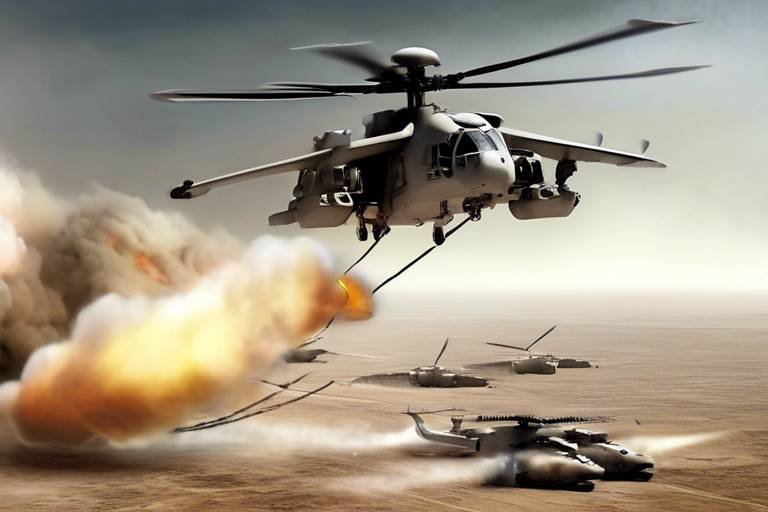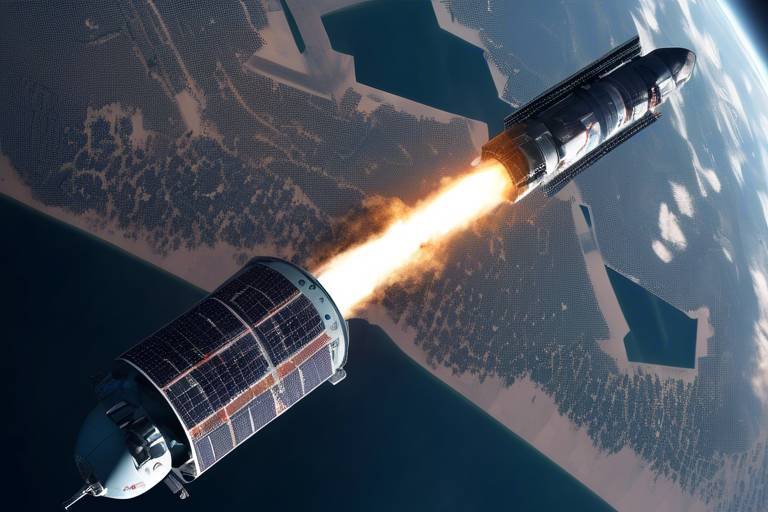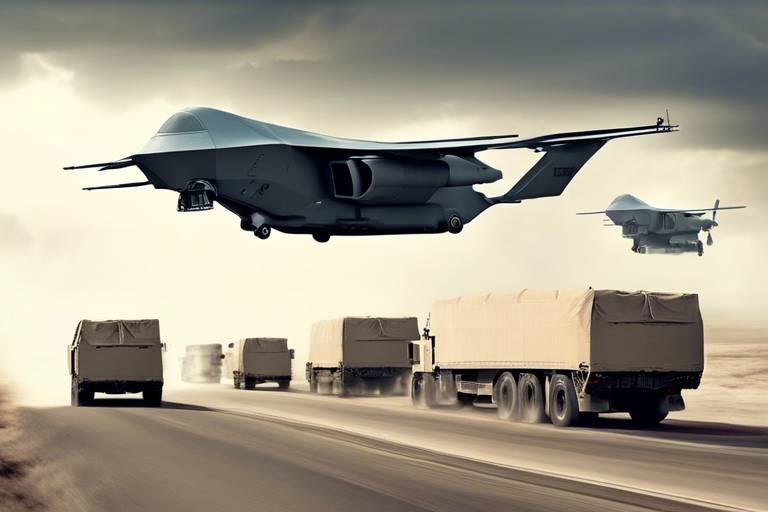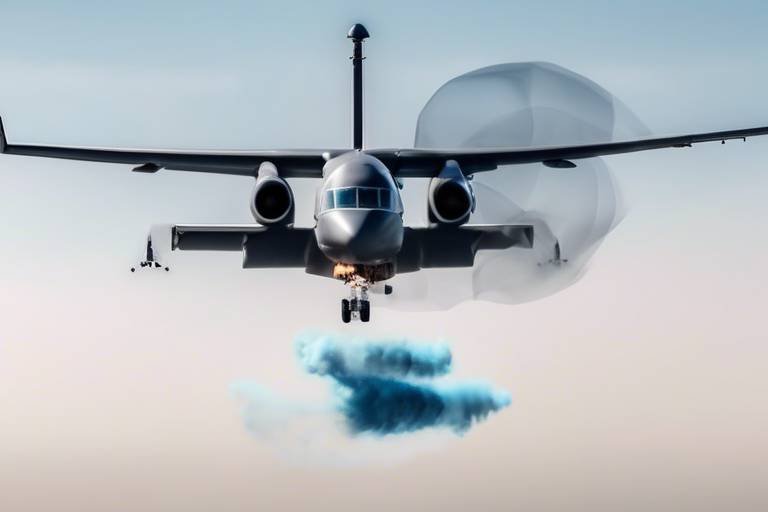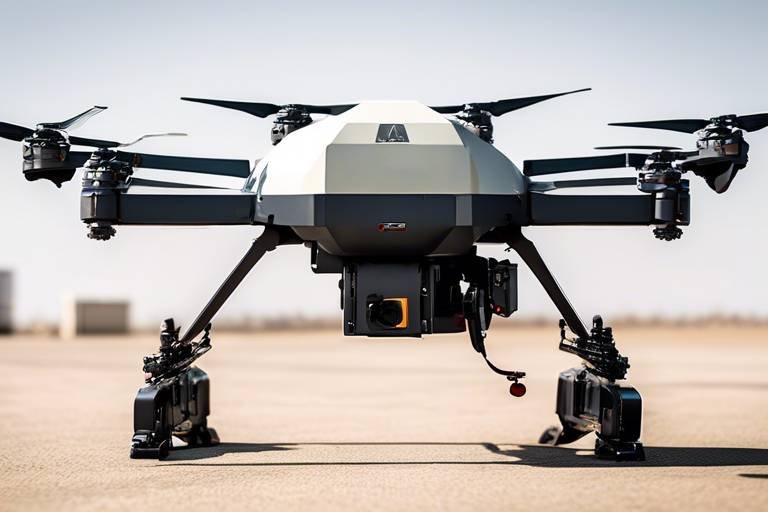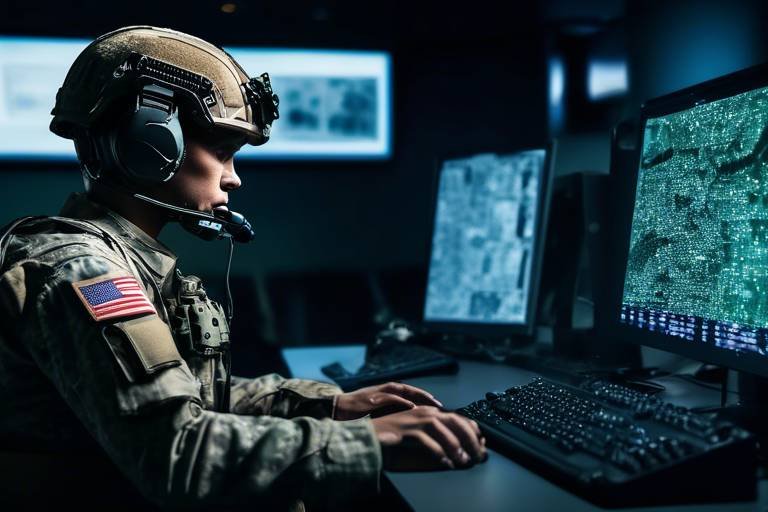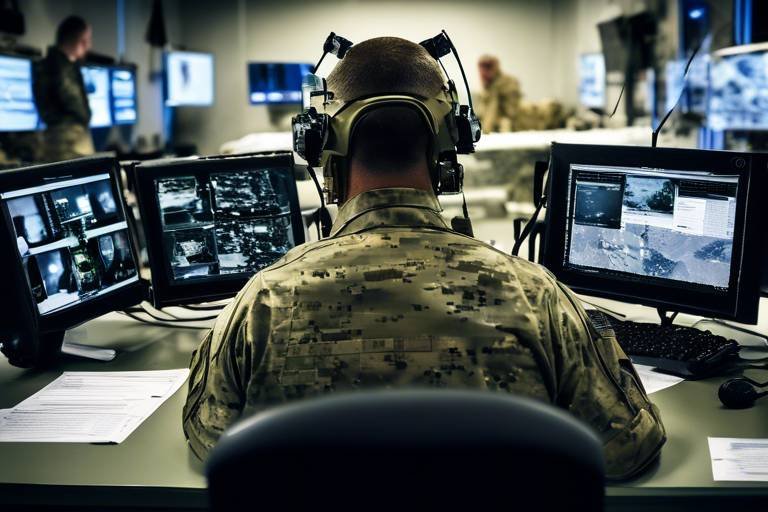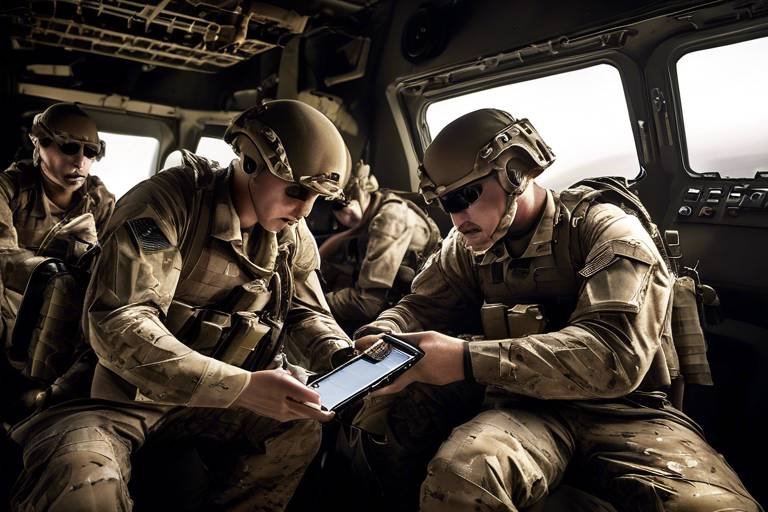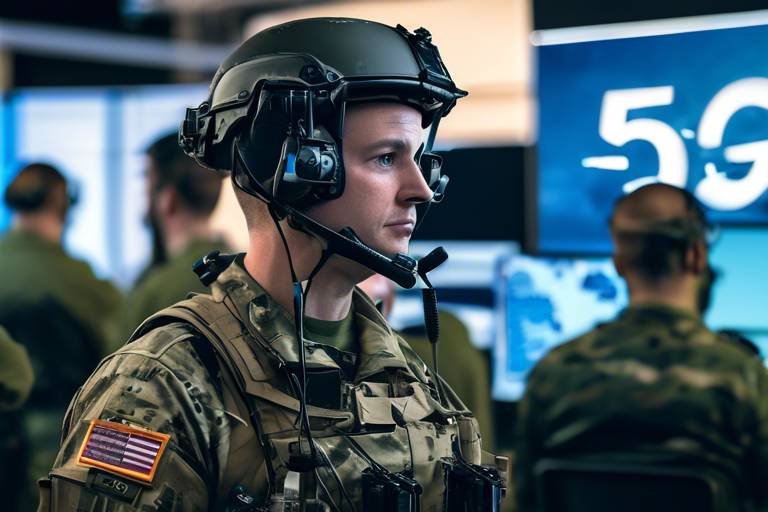How AI is Optimizing Military Medical Response
In the ever-evolving landscape of military operations, the integration of artificial intelligence (AI) is proving to be a game-changer, especially in the realm of medical response. Imagine a battlefield where decisions about life and death are made not just by human instinct, but with the backing of powerful algorithms that can process data at lightning speed. This is not science fiction; it’s the reality of modern military medicine. AI is enhancing efficiency, boosting accuracy, and ultimately increasing the effectiveness of medical care in critical situations. From the moment a soldier is injured to the time they receive treatment, AI is playing a pivotal role in ensuring that every second counts.
One of the most significant ways AI is optimizing military medical response is through its ability to analyze data rapidly. In chaotic environments, where every second matters, traditional methods of triage can be too slow. AI can assess a patient’s condition almost instantaneously, allowing military medics to prioritize care based on urgency and severity. This capability can mean the difference between life and death for injured soldiers in combat zones. Imagine a system that can predict which soldier needs immediate attention based on their injuries, while also considering the availability of medical resources. This is the future of military triage, and it’s here now.
Moreover, AI's predictive analytics capabilities are revolutionizing how military operations allocate resources. By forecasting medical needs during missions, AI ensures that supplies and personnel are optimally positioned. Think of it as a chess game where every move is calculated in advance. With AI, military leaders can anticipate healthcare demands, avoiding the pitfalls of being underprepared or overwhelmed. This proactive approach not only saves lives but also enhances the overall effectiveness of military operations.
In addition to resource allocation, AI is paving the way for data-driven decision-making. By analyzing vast amounts of historical and real-time data, military leaders gain actionable insights that inform their strategies. This data-driven approach means that decisions are based on facts rather than intuition, leading to more effective medical responses in the field. Imagine being able to look at past operations and understand what worked, what didn’t, and why. This level of insight is invaluable in high-stakes environments.
Integrating AI with existing military medical systems enhances operational efficiency significantly. It allows for smoother communication and coordination among medical teams during critical missions. Picture a scenario where medics in the field can instantly share patient information with hospitals, ensuring that everyone is on the same page. This seamless integration is crucial for timely and effective medical care.
Furthermore, AI-driven training simulations are enhancing the skills of military medics. These simulations provide realistic scenarios that prepare medics for various medical emergencies they might encounter in combat situations. It’s like a virtual boot camp for medical professionals, where they can hone their skills without the risks associated with real-life training. The more prepared they are, the better they can respond when it truly matters.
Real-time monitoring and diagnostics are yet another area where AI shines. By facilitating constant monitoring of injured personnel, AI enables accurate diagnostics and timely interventions. In battlefield conditions, where every moment counts, this capability is crucial for improving survival rates. Imagine a system that alerts medics to changes in a soldier’s condition before they even realize something is wrong. This proactive approach can significantly enhance outcomes.
Telemedicine is also being transformed by AI, allowing remote medical experts to assist frontline medics in real-time. This means that even in the most isolated locations, soldiers can receive expert care. It’s like having a world-class doctor in your pocket, ready to provide guidance at a moment's notice. This capability not only improves the quality of care but also boosts the morale of troops who know that help is always available.
Communication between different military units is streamlined through AI tools, ensuring that medical support is coordinated efficiently. In the chaos of military operations, having clear and prompt communication can be the difference between success and failure. AI helps ensure that critical information is shared quickly, allowing for a cohesive response to medical emergencies.
Finally, implementing feedback loops powered by AI helps military medical teams learn from past operations. This continuous improvement process is vital for refining protocols and responses based on real-world experiences. It’s like having a personal coach that helps you analyze your performance and improve over time. With each operation, military medics can adapt and evolve, leading to better outcomes for everyone involved.
- How does AI improve triage in military settings? AI analyzes patient data rapidly, allowing medics to prioritize care based on urgency and severity.
- What role does predictive analytics play in military operations? Predictive analytics forecasts medical resource needs, ensuring optimal allocation during missions.
- Can AI enhance training for military medics? Yes, AI-driven simulations provide realistic training scenarios that improve medics' preparedness for emergencies.
- How does telemedicine benefit from AI in military contexts? AI enables remote medical experts to assist frontline medics in real-time, ensuring soldiers receive expert care even in isolated areas.

AI in Triage Systems
Artificial intelligence is not just a buzzword in the tech world; it’s a game-changer in military medical response, especially when it comes to triage systems. Imagine a battlefield where every second counts, and the difference between life and death hangs on the ability to assess injuries quickly and accurately. Traditional triage methods, while effective, can be slow and prone to human error. This is where AI steps in, revolutionizing the way military medics prioritize care based on urgency and severity.
AI algorithms can analyze patient data in mere seconds, processing information from various sources such as vital signs, injury types, and even historical data from similar cases. This rapid analysis allows medics to make informed decisions on who needs immediate attention and who can wait, ultimately saving lives in high-pressure environments. For instance, a soldier with a severe head injury will be prioritized over one with a minor fracture, ensuring that those in critical condition receive the care they need without delay.
Moreover, AI-driven triage systems can adapt to changing conditions on the battlefield. As new data comes in—perhaps from ongoing assessments or shifts in medical supply availability—these systems can recalibrate priorities. This is akin to having a personal assistant who not only keeps track of your schedule but also adjusts it in real-time based on new information. The flexibility and responsiveness of AI in triage systems create a dynamic environment where decisions are made with the utmost precision.
One of the most impressive features of AI in triage is its ability to learn from past experiences. By analyzing outcomes from previous missions, AI can identify patterns and improve its predictive capabilities. This continuous learning process means that military medics are always equipped with the best possible information to make critical decisions. The integration of AI into triage systems is not just about speed; it's about enhancing accuracy and ensuring that every soldier receives the appropriate level of care they deserve.
As we look towards the future, the implementation of AI in military triage systems is set to expand even further. With advancements in machine learning and data analytics, we can expect to see even more sophisticated systems that not only triage injuries but also forecast potential medical needs based on troop movements and mission objectives. This proactive approach could lead to a significant reduction in casualties and improved overall outcomes for military personnel.
- What is the primary benefit of AI in triage systems? The main advantage is the ability to analyze patient data rapidly, allowing medics to prioritize care based on urgency and severity, which saves lives.
- How does AI improve decision-making in medical emergencies? AI analyzes vast amounts of historical and real-time data to provide actionable insights, helping medics make informed choices during critical situations.
- Can AI systems adapt to changing battlefield conditions? Yes, AI-driven triage systems can recalibrate priorities in real-time based on new data, ensuring that the most critical cases are addressed first.
- Is AI in triage systems only beneficial for military applications? While this article focuses on military use, AI in triage systems can also be applied in civilian healthcare settings, improving emergency response across various scenarios.

Predictive Analytics for Resource Allocation
In the high-stakes world of military operations, where every second counts and resources are often limited, predictive analytics emerges as a game-changer. Imagine a scenario where military leaders can foresee the medical needs of their troops even before they arise. This is not just wishful thinking; it’s the power of AI-driven predictive analytics at work. By analyzing historical data, real-time information, and even environmental factors, military medical teams can anticipate the demand for medical supplies and personnel, ensuring they are always one step ahead.
At its core, predictive analytics utilizes complex algorithms and machine learning models to sift through vast amounts of data. For instance, by examining past military engagements, AI can identify patterns in injuries and illnesses that typically occur in specific environments or situations. This allows commanders to prepare adequately, stocking up on necessary supplies like bandages, medications, and even specialized equipment before they are needed on the battlefield.
Consider a military operation in a remote area where combat injuries are expected to spike due to an anticipated enemy engagement. With predictive analytics, military planners can forecast the number of casualties and the types of injuries likely to occur. This foresight enables them to allocate resources efficiently, ensuring that medical teams are equipped and ready to respond effectively. The benefits are not just limited to preparation; they extend to operational efficiency, improving the overall survival rates of injured personnel.
Furthermore, predictive analytics can also enhance the management of personnel. By analyzing data on medics’ performance, fatigue levels, and even morale, military leaders can make informed decisions about staffing and rotations. This ensures that the right number of medics are available when and where they are needed most, reducing burnout and improving response times. The table below illustrates how predictive analytics can optimize various aspects of resource allocation:
| Aspect | Traditional Approach | Predictive Analytics Approach |
|---|---|---|
| Supply Management | Reactive ordering based on current needs | Proactive forecasting based on historical data |
| Personnel Allocation | Static assignments | Dynamic adjustments based on predictive models |
| Response Planning | Ad-hoc strategies | Data-driven, scenario-based planning |
In addition to these advantages, predictive analytics also plays a pivotal role in real-time adjustments. During an operation, conditions can change rapidly, and injuries may not follow expected patterns. AI systems can continuously analyze incoming data and adjust forecasts accordingly, allowing military medical teams to shift resources on the fly. This adaptability is crucial in dynamic environments where the situation can evolve in moments.
Ultimately, the integration of predictive analytics into military medical response is about more than just efficiency; it’s about saving lives. By ensuring that medical resources are allocated optimally, military leaders can provide timely care to those who need it most, enhancing the overall effectiveness of military operations. As we continue to embrace the capabilities of AI, the future of military medicine looks not only promising but also profoundly transformative.
- What is predictive analytics in military medicine? Predictive analytics involves using data analysis techniques to forecast future medical resource needs based on historical and real-time data.
- How does AI improve resource allocation? AI can analyze vast amounts of data to identify patterns and trends, allowing for better forecasting and preparation of medical resources.
- Can predictive analytics help in emergency situations? Yes, it enables military leaders to make data-driven decisions quickly, ensuring that medical teams are prepared for unexpected spikes in injuries.
- What are the benefits of using predictive analytics? The benefits include improved efficiency, better resource management, enhanced response times, and ultimately, higher survival rates for injured personnel.

Data-Driven Decision Making
In the high-stakes environment of military operations, has emerged as a game-changer. Imagine being in a battlefield where every second counts, and the difference between life and death hinges on the decisions made by military leaders. This is where artificial intelligence (AI) steps in, analyzing a treasure trove of historical and real-time data to provide actionable insights. By harnessing the power of AI, military personnel can make informed decisions that enhance the effectiveness of medical responses.
AI algorithms sift through mountains of data, identifying patterns and trends that human analysts might overlook. For instance, by examining past medical incidents, AI can predict which injuries are most likely to occur in specific combat scenarios. This predictive capability allows military medical teams to prepare accordingly, ensuring that they have the right resources and personnel in place before an operation even begins. It’s like having a crystal ball that reveals not just the present but also the future, enabling proactive rather than reactive responses.
Moreover, the integration of AI into decision-making processes fosters a culture of continuous improvement. By analyzing outcomes from previous missions, military leaders can refine their strategies and protocols. For example, if data shows that a particular treatment was effective in a specific type of injury, that knowledge can be disseminated across units, ensuring that all medics are equipped with the best practices. This not only enhances individual performance but also elevates the overall standard of care provided to soldiers in the field.
To illustrate the impact of data-driven decision making in military medical response, consider the following table that outlines key benefits:
| Benefit | Description |
|---|---|
| Improved Accuracy | AI analyzes vast amounts of data to identify the most effective treatment options based on real-time conditions. |
| Resource Optimization | Predictive analytics forecast medical needs, ensuring that supplies are allocated efficiently. |
| Enhanced Training | Data insights inform training programs, preparing medics for the most common injuries encountered in combat. |
In conclusion, data-driven decision making, powered by AI, transforms military medical response from a reactive approach to a proactive strategy. It equips military leaders with the insights they need to make informed choices, ultimately saving lives and improving the overall effectiveness of medical operations on the battlefield. As technology continues to evolve, the potential for AI to enhance decision-making processes will only grow, paving the way for a new era in military healthcare.
- How does AI improve triage in military settings?
AI analyzes patient data quickly to prioritize care based on urgency, ensuring that the most critical cases receive immediate attention. - What role does predictive analytics play in military operations?
Predictive analytics help forecast medical resource needs, allowing for optimal allocation of supplies and personnel during missions. - Can AI enhance training for military medics?
Yes, AI-driven simulations provide realistic training scenarios, helping medics improve their skills and preparedness for various medical emergencies.
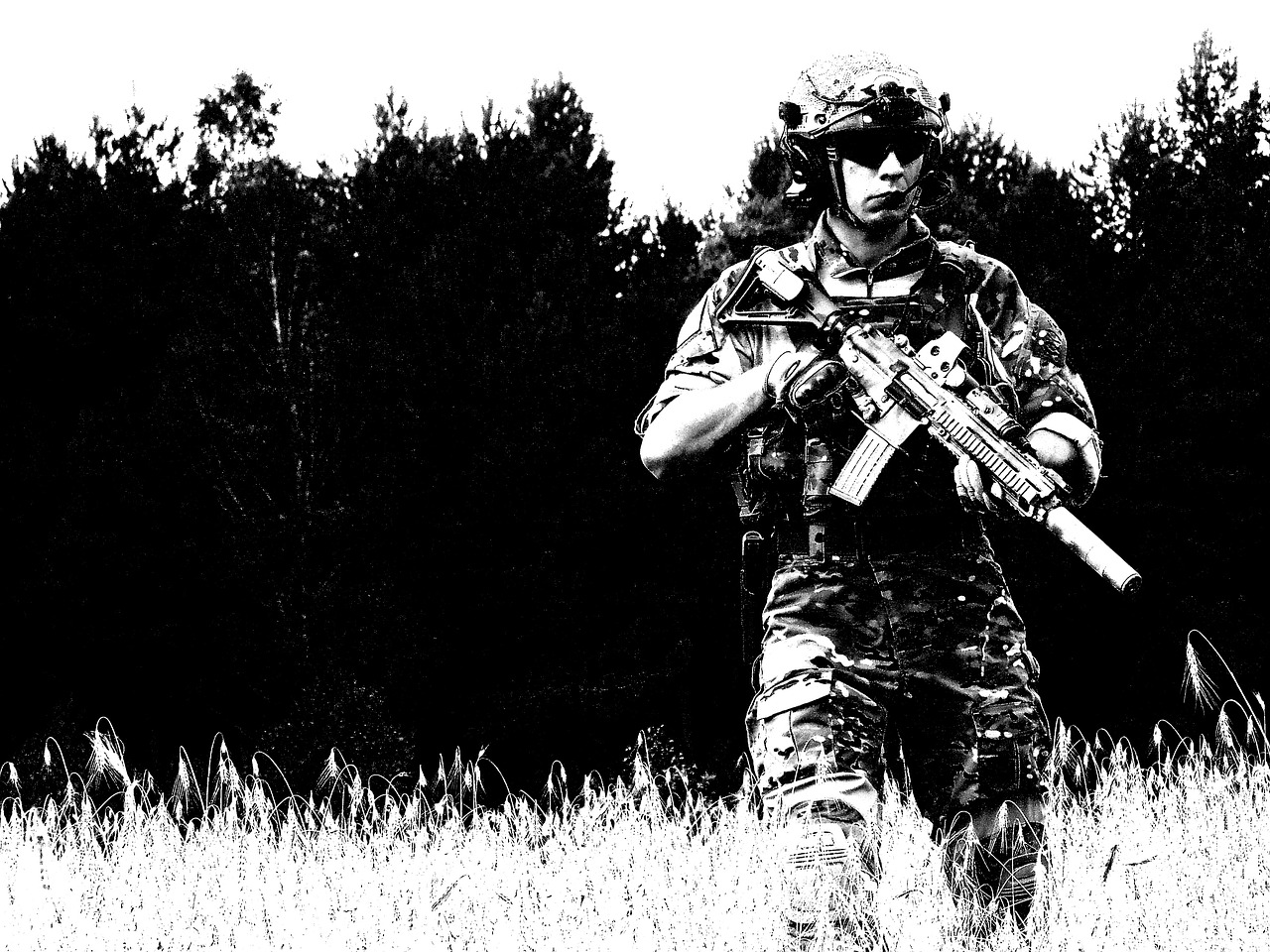
Integration with Existing Systems
Integrating artificial intelligence with existing military medical systems is a game changer. Imagine a scenario where medics in the field have access to a seamless flow of information, allowing them to make quick, informed decisions. This integration is not just about technology; it's about enhancing the human element of care in high-pressure situations. By connecting AI-driven tools with current medical databases and communication platforms, military medical teams can operate with unprecedented efficiency.
One of the primary benefits of this integration is the ability to streamline communication between various units. With AI systems in place, medics can receive real-time updates on the status of injured personnel, ensuring that they are always one step ahead in providing care. This is crucial in combat zones where every second counts. For instance, if a unit reports multiple casualties, AI can quickly analyze the incoming data and prioritize which patients need immediate attention based on their injuries and vital signs.
Furthermore, the integration of AI can significantly reduce the chances of human error. Traditional methods often rely on manual data entry and communication, which can lead to mistakes in critical situations. However, AI systems can automate data collection and analysis, allowing for more accurate and timely responses. This not only enhances the effectiveness of medical interventions but also builds trust among the personnel who rely on these systems.
Additionally, AI can assist in training medics by simulating various scenarios based on historical data. This means that when new protocols are introduced, they can be tested in a controlled environment before being implemented in the field. By using AI-driven simulations, medics can practice their skills and improve their readiness for real-life emergencies.
In terms of logistics, integrating AI with existing systems also helps in managing medical supplies more effectively. By analyzing usage patterns and predicting future needs, AI can ensure that the right amount of medical supplies is available at the right time. This proactive approach minimizes waste and ensures that medics are always equipped to handle emergencies.
In conclusion, the integration of AI with existing military medical systems is not just a technological upgrade; it's a comprehensive enhancement of the entire medical response framework. By fostering better communication, reducing errors, improving training, and optimizing resource management, AI is paving the way for a more effective and responsive military medical service.
- How does AI improve communication in military medical units? AI streamlines communication by providing real-time updates and data analysis, ensuring that medics have the information they need to make quick decisions.
- Can AI reduce human error in medical responses? Yes, AI automates data collection and analysis, which minimizes the chances of mistakes that can occur with manual processes.
- What role does AI play in training military medics? AI-driven simulations create realistic scenarios for training, allowing medics to practice and refine their skills in a controlled environment.
- How does AI help in managing medical supplies? AI analyzes usage patterns and predicts future needs, ensuring that medical supplies are optimally allocated and reducing waste.

Training and Simulation Enhancements
In the ever-evolving landscape of military operations, powered by artificial intelligence (AI) are proving to be game-changers. Imagine a world where military medics can practice their skills in a hyper-realistic environment that mimics the chaos of real combat situations. This is no longer a distant dream; it’s happening right now! AI-driven training simulations provide a platform where medics can hone their abilities, making mistakes in a safe environment, and learning from them without the dire consequences that would occur in the field.
These advanced simulations utilize real-time data and historical scenarios to create immersive experiences. For instance, when a medic enters a simulation, they might face a variety of medical emergencies, from treating gunshot wounds to managing traumatic brain injuries. The AI can adjust the difficulty level based on the medic's performance, ensuring that each training session is tailored to their specific needs. This adaptability not only enhances learning but also builds confidence among medics, preparing them for high-pressure situations.
Moreover, the incorporation of AI in training allows for a more collaborative learning environment. Medics can train alongside other military personnel, fostering teamwork and communication skills that are vital during real missions. Imagine a scenario where a medic must coordinate with a combat unit while managing a casualty. AI simulations can replicate these dynamics, ensuring that medics are not only skilled in medical procedures but also adept at communicating under stress.
In addition to improving individual skills, AI simulations can also facilitate team-based training. By analyzing the interactions between team members, AI can identify areas for improvement, helping teams to function more effectively in real-world operations. This holistic approach to training ensures that every member of the medical team is prepared to support each other, creating a seamless flow of care in critical situations.
As we look to the future, the potential of AI in military training is immense. The ability to conduct after-action reviews powered by AI analytics means that medics can receive feedback not just on their performance, but also on the effectiveness of their teamwork and decision-making processes. This continuous feedback loop is essential for ongoing improvement and adaptation to new challenges on the battlefield.
In conclusion, AI is not just enhancing training and simulations for military medics; it is redefining what it means to be prepared for the unexpected. By creating realistic, adaptable, and collaborative training environments, AI ensures that our military medical teams are ready to face the complexities of modern warfare with confidence and skill.
- How does AI improve military medical training?
AI enhances military medical training by providing realistic simulations that adapt to the medic's skill level, allowing for personalized learning experiences. - What types of scenarios can AI simulations replicate?
AI simulations can replicate various medical emergencies, including trauma care, surgical procedures, and emergency response in combat situations. - Can AI simulations help with team training?
Yes, AI simulations facilitate team-based training, improving communication and coordination among medical personnel during high-stress situations. - What is an after-action review?
An after-action review is a process where AI analyzes training sessions to provide feedback on performance, helping medics learn from their experiences and improve future responses.
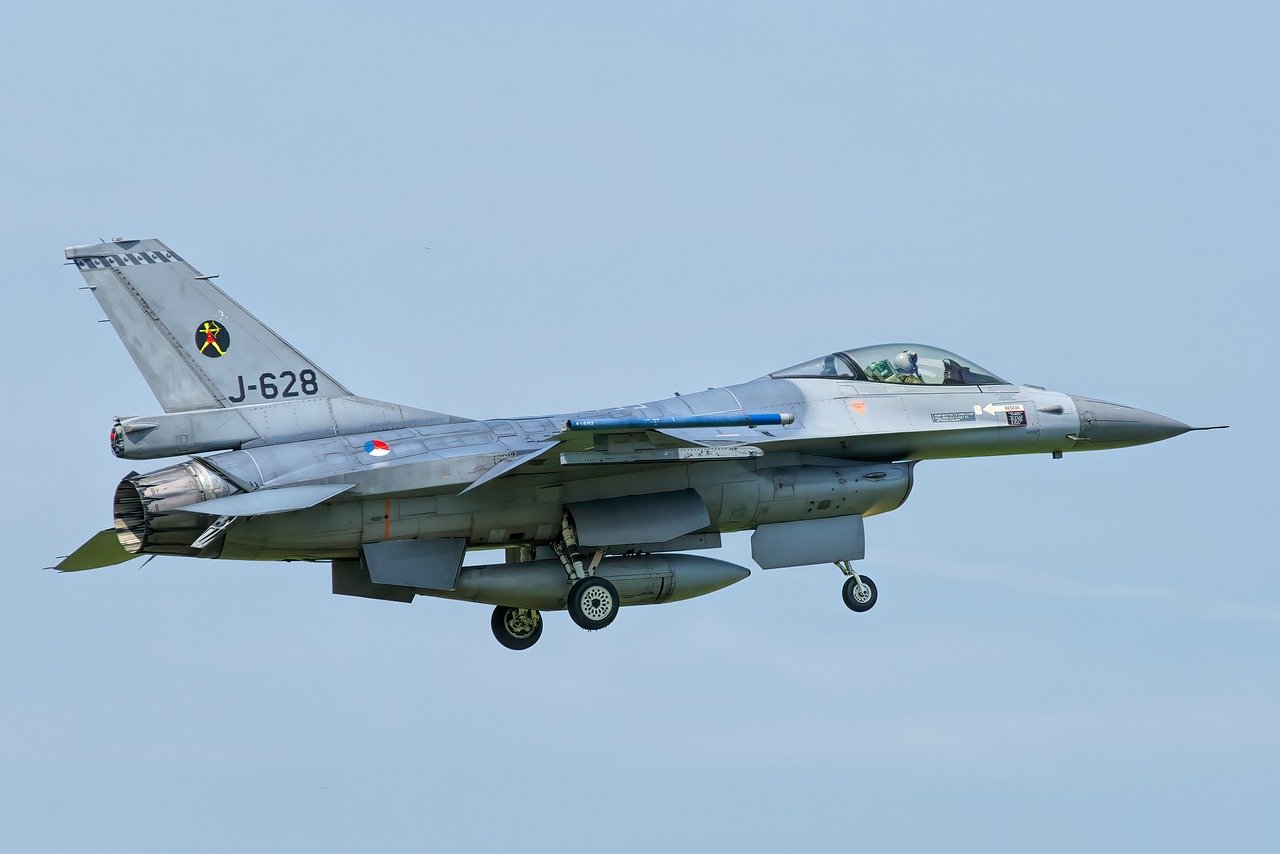
Real-time Monitoring and Diagnostics
In the high-stakes environment of military operations, play a critical role in ensuring the health and safety of soldiers on the battlefield. Imagine a scenario where a soldier is injured; every second counts, and the ability to assess their condition instantly can mean the difference between life and death. This is where artificial intelligence (AI) steps in, transforming traditional medical practices into a more responsive and effective system.
AI-powered technologies enable the continuous monitoring of vital signs and other health indicators of injured personnel. By utilizing advanced algorithms, these systems can analyze data from wearable devices or sensors that track heart rate, blood pressure, oxygen levels, and more. This real-time data is invaluable, allowing medics to make informed decisions quickly. For instance, if a soldier's heart rate spikes or blood pressure drops dramatically, the AI can alert medical personnel immediately, prompting them to take swift action.
The integration of AI in diagnostics also enhances the accuracy of assessments. Traditional methods often rely on subjective evaluations, which can vary from one medic to another. With AI, however, the analysis is data-driven and consistent. It can recognize patterns that might be overlooked by human eyes, ensuring that no critical detail is missed. For example, an AI system can analyze imaging data from X-rays or CT scans in seconds, identifying fractures or internal injuries that require urgent intervention.
Moreover, the ability to monitor soldiers remotely means that even in the most isolated locations, expert medical advice is just a click away. This is particularly beneficial in combat zones where access to medical facilities is limited. Telemedicine powered by AI allows frontline medics to connect with specialists who can provide guidance based on real-time data. This collaboration not only improves the quality of care but also boosts the confidence of medics in their decision-making processes.
To illustrate the impact of real-time monitoring and diagnostics, consider the following table that highlights key benefits:
| Benefit | Description |
|---|---|
| Immediate Alerts | AI systems can send instant notifications to medics regarding critical changes in a patient's condition. |
| Enhanced Accuracy | Data-driven diagnostics reduce the risk of human error, leading to more effective treatment plans. |
| Remote Expertise | Frontline medics can access specialized medical knowledge without needing to evacuate injured personnel. |
| Comprehensive Data Analysis | AI can analyze vast amounts of data quickly, providing insights that help in making informed decisions. |
In conclusion, the integration of AI in real-time monitoring and diagnostics is reshaping how military medical teams respond to emergencies. By harnessing the power of technology, they can ensure that soldiers receive the best possible care, even in the most challenging environments. As we look to the future, it's clear that AI will continue to be an essential component in optimizing military medical response, ultimately enhancing the survival rates and overall well-being of our troops.
- How does AI improve real-time monitoring in military medical response? AI enhances real-time monitoring by analyzing vital signs and health indicators instantly, allowing for immediate medical interventions.
- Can AI diagnostics replace human medics? While AI provides valuable insights and enhances accuracy, it is meant to assist human medics, not replace them. The human touch in medical care is irreplaceable.
- What are the main benefits of using AI in military medicine? Key benefits include immediate alerts for critical conditions, enhanced diagnostic accuracy, access to remote expertise, and comprehensive data analysis.

Telemedicine and Remote Support
In the ever-evolving landscape of military medicine, telemedicine has emerged as a game-changer, especially in the context of remote support. Imagine a scenario where a soldier is injured in a remote combat zone, far from any medical facility. In the past, this might have meant a race against time, with every second counting. However, with the integration of artificial intelligence in telemedicine, frontline medics can now connect with medical experts who are miles away in real-time. This capability not only enhances the quality of care but also significantly increases the chances of survival for injured personnel.
AI-powered telemedicine platforms facilitate seamless communication between medics and specialists, ensuring that critical medical advice can be provided without delay. For instance, a medic on the field can transmit vital signs and injury details to a remote doctor, who can then analyze the data and provide immediate guidance on treatment protocols. This is akin to having a seasoned physician right there in the trenches, ready to offer expert advice at a moment's notice.
Moreover, the use of telemedicine in military operations extends beyond immediate care. It also serves as a vital tool for training and education. Medics can engage in virtual training sessions with experienced professionals, learning the latest techniques and protocols that can be applied in real-life scenarios. This ongoing education ensures that military personnel are not just reacting to situations, but are also well-prepared for them.
One of the standout features of AI-driven telemedicine is its ability to analyze data and predict potential medical issues before they escalate. By monitoring trends and patterns in injuries or illnesses, the system can alert medics to emerging health threats, enabling proactive measures. This predictive capability is crucial in a military context, where the environment is often unpredictable and hostile.
To illustrate the impact of telemedicine on military medical response, consider the following table that highlights key benefits:
| Benefit | Description |
|---|---|
| Immediate Access to Expertise | Remote specialists can provide real-time support to frontline medics, improving decision-making. |
| Enhanced Training Opportunities | Medics can participate in virtual training sessions, keeping their skills sharp and up-to-date. |
| Proactive Health Monitoring | AI can identify trends in injuries, allowing for early intervention and resource allocation. |
| Improved Communication | Streamlined communication between units ensures that medical support is coordinated effectively. |
In essence, telemedicine and remote support powered by AI represent a significant leap forward in military medical response. By bridging the gap between frontline medics and specialists, these technologies not only enhance the quality of care but also contribute to the overall effectiveness of military operations. As we continue to embrace these innovations, the future of military medicine looks brighter than ever, ensuring that our brave personnel receive the best possible care, no matter where they are stationed.
- What is telemedicine in the military context?
Telemedicine refers to the use of technology to provide medical care and consultation remotely, allowing military medics to connect with specialists in real-time. - How does AI enhance telemedicine?
AI enhances telemedicine by analyzing data, predicting medical needs, and facilitating communication between medics and remote experts. - Can telemedicine improve training for military medics?
Yes, telemedicine provides opportunities for virtual training sessions, helping medics stay updated on the latest medical practices and protocols. - What are the benefits of using telemedicine in combat zones?
Benefits include immediate access to expert advice, enhanced training, proactive health monitoring, and improved communication among medical units.

Communication Between Units
Effective communication between military units is a critical component of successful operations, especially in high-stakes environments like combat zones. When the chaos of battle erupts, the ability to share information swiftly and accurately can mean the difference between life and death. This is where artificial intelligence (AI) steps in as a game changer. By utilizing advanced algorithms and real-time data processing, AI tools can streamline communication, ensuring that every unit is on the same page.
Imagine a scenario where a medical team is treating injured soldiers while under fire. They need to relay information about the condition of the casualties to other units, request additional medical supplies, or even call for evacuation. With AI-enhanced communication systems, messages can be transmitted instantly, with minimal risk of miscommunication. These systems can prioritize messages based on urgency, ensuring that the most critical information reaches the right people at the right time.
Moreover, AI can integrate various communication channels, such as radios, satellite systems, and mobile devices, into a cohesive network. This integration allows for seamless information flow, enabling units to coordinate their efforts more effectively. For instance, if one unit identifies a new threat, they can quickly share that information with nearby units, allowing for a swift tactical response. This kind of agility is essential in modern warfare, where situations can change in the blink of an eye.
To illustrate the impact of AI on communication, consider the following table that outlines the benefits:
| Benefit | Description |
|---|---|
| Speed | AI systems can process and relay information faster than human operators, reducing response times. |
| Accuracy | With AI, the likelihood of miscommunication is drastically reduced, ensuring that critical information is conveyed correctly. |
| Integration | AI can connect various communication tools into a unified system, enhancing interoperability among units. |
| Real-time Updates | Units can receive instant updates on the battlefield conditions, allowing for informed decision-making. |
Furthermore, AI can analyze communication patterns and identify potential bottlenecks or inefficiencies in the information flow. By assessing these patterns, military leaders can implement improvements that enhance overall operational effectiveness. It's like having a coach who not only guides you during the game but also reviews your performance afterward to help you play better next time.
In summary, the integration of AI into communication systems between military units is not just a technological upgrade; it's a fundamental shift in how military operations are conducted. By ensuring that information is shared quickly and accurately, AI enhances the ability of units to work together, respond to threats, and ultimately save lives. As we continue to explore the capabilities of AI, one thing is clear: the future of military communication is not just about technology—it's about transforming the way we think about teamwork in the most challenging environments.
- How does AI improve communication in military operations?
AI enhances communication by processing and relaying information swiftly, reducing response times, and minimizing miscommunication. - What are the benefits of integrating AI with existing communication systems?
Integration allows for seamless information flow, real-time updates, and better coordination among units. - Can AI help in emergency situations?
Yes, AI can prioritize and relay critical information during emergencies, ensuring timely responses to save lives. - Is AI communication reliable in combat zones?
AI systems are designed to be robust and accurate, significantly reducing the chances of miscommunication in high-stress environments.

Feedback Loops for Continuous Improvement
In the ever-evolving landscape of military medicine, feedback loops are becoming an essential component for ensuring that medical teams can adapt and improve their operations continuously. Imagine a feedback loop as a cycle of learning, where each mission provides valuable insights that contribute to the next. This concept is not just theoretical; it has practical implications that can significantly enhance the effectiveness of military medical responses in the field.
By utilizing artificial intelligence to analyze the outcomes of medical interventions, military leaders can identify patterns and trends that might otherwise go unnoticed. For instance, if a particular treatment protocol consistently leads to better patient outcomes, AI can highlight this, allowing medics to adopt these practices more widely. Conversely, if certain methods result in poor outcomes, they can be revised or discarded based on data-driven evidence.
Moreover, these feedback loops can be structured to gather information from multiple sources. This includes not just the immediate medical results but also feedback from the medics themselves, who can share their experiences and insights. This can create a rich tapestry of data that informs future training and operational strategies. Real-time data collection and analysis enable teams to adjust their tactics on the fly, ensuring that they are always operating with the best available information.
To illustrate, consider a scenario where a unit is deployed in a combat zone. After a series of missions, the data collected might reveal that certain injuries are more prevalent than anticipated. Utilizing this information, military medical planners can adjust their training programs to focus on these specific injuries, ensuring that medics are better prepared when they encounter them in future operations. This proactive approach not only enhances the skills of the medical teams but also improves patient outcomes, ultimately saving lives.
Furthermore, feedback loops can enhance collaboration between different military units. When one unit shares its experiences, it can inform others about what worked and what didn’t, fostering a culture of continuous improvement. Such collaboration can be facilitated through AI-powered platforms that allow for seamless communication and data sharing, creating a network of knowledge that benefits all involved.
In summary, feedback loops powered by AI are not just a luxury; they are a necessity for military medical teams striving for excellence. By embracing this cycle of learning and adaptation, the military can ensure that its medical response capabilities are always evolving, ultimately leading to better care for those who serve on the front lines.
- What are feedback loops in military medicine?
Feedback loops refer to the process of gathering data from medical operations to inform and improve future practices and protocols. - How does AI enhance feedback loops?
AI analyzes vast amounts of data to identify patterns and trends, enabling military teams to make informed decisions based on real-world outcomes. - Why are feedback loops important?
They allow military medical teams to continuously adapt and improve their responses, leading to better patient outcomes and more effective operations. - Can feedback loops improve training for military medics?
Yes, by highlighting areas that need improvement, feedback loops can inform training programs, ensuring medics are prepared for the challenges they may face.
Frequently Asked Questions
- How does AI improve triage systems in military medical response?
AI enhances triage systems by rapidly analyzing patient data, which allows military medics to prioritize care based on the urgency and severity of injuries. This quick assessment can be the difference between life and death in combat zones, ensuring that the most critical cases receive immediate attention.
- What role does predictive analytics play in military healthcare?
Predictive analytics helps forecast medical resource needs during military operations. By anticipating healthcare demands, military leaders can allocate supplies and personnel more effectively, ensuring that resources are available where and when they are needed most.
- How does AI facilitate data-driven decision making?
AI analyzes vast amounts of historical and real-time data, providing military leaders with actionable insights. These insights enable them to make informed decisions regarding medical response strategies, improving overall effectiveness in the field.
- Can AI integrate with existing military medical systems?
Absolutely! Integrating AI with current military medical systems enhances operational efficiency. This integration allows for smoother communication and coordination among medical teams, which is crucial during critical missions.
- How does AI enhance training for military medics?
AI-driven training simulations create realistic scenarios that help military medics improve their skills and preparedness for various medical emergencies they may face in combat. This innovative training approach ensures that medics are ready for the unexpected.
- What benefits does real-time monitoring provide in battlefield conditions?
Real-time monitoring facilitated by AI enables accurate diagnostics and timely interventions for injured personnel. This capability is crucial for improving survival rates in challenging battlefield conditions, allowing medics to respond quickly to evolving situations.
- How does AI support telemedicine in military operations?
AI enhances telemedicine capabilities by allowing remote medical experts to assist frontline medics in real-time. This ensures that soldiers receive expert care even in the most isolated locations, bridging the gap between the battlefield and advanced medical support.
- What is the significance of communication between military units?
Effective communication between different military units is vital for coordinated medical support. AI tools streamline this communication, ensuring that critical information is shared promptly during operations, which can significantly impact the outcome of medical responses.
- How do feedback loops powered by AI contribute to military medical teams?
Implementing AI-powered feedback loops allows military medical teams to learn from past operations. This continuous improvement process helps refine protocols and responses based on real-world experiences, ultimately enhancing the effectiveness of medical care provided in future missions.


